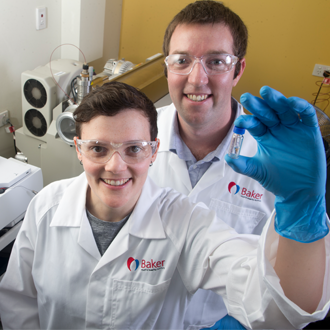14 September 2020
Institute news
A team at the Baker Institute is developing a ‘metabolic BMI’ and ‘metabolic age’ to help people better understand how well their metabolism is working and when they need to intervene to prevent disease.
 Project leader and Head of Metabolomics Professor Peter Meikle said dysregulation of our metabolism underpinned many chronic diseases including obesity, type 2 diabetes, cardiovascular disease and age-related dementia.
Project leader and Head of Metabolomics Professor Peter Meikle said dysregulation of our metabolism underpinned many chronic diseases including obesity, type 2 diabetes, cardiovascular disease and age-related dementia.
“How our body metabolises the food we eat — burns it to produce energy, changes it into other compounds for growth, or stores it as fat – affects our risk of these ‘metabolic’ diseases,” Professor Meikle said.
“The metabolic system is very complicated, with thousands of different lipids (fats) and metabolites. In my lab we’ve found a way to closely examine people’s lipid profile to better understand which lipids are associated with a well-functioning metabolism, and therefore lower risk of disease, and which indicate a higher risk.
“By taking a drop of blood we can identify about 750 lipid species in 15 minutes and use them to predict a person’s risk of metabolic disease.”
Traditionally a person’s metabolic health is calculated using much blunter instruments like cholesterol, blood pressure or body mass index (BMI).
“For the past 60 years, clinicians have been focused on three main lipid measures to assess disease risk — low-density lipoprotein (LDL) high-density lipoprotein (HDL) and triglycerides,” Professor Meikle said.
“This is a bit like classifying vehicles as cars, motorbikes and trucks. But by looking at 750 lipids instead of just three, our profiling gives us access to so much more detail. It essentially allows us to drill down to the vehicle’s make, model, year and even how many kilometers it’s clocked up to assess its condition.”
Professor Meikle is using these biomarkers to develop risk measurements based on concepts people already understand — BMI and age — to provide greater incentive for action to prevent disease.
“While our metabolism does change as we age or as our BMI increases, we know that two individuals with the same measured BMI or age can have different levels of metabolic health. That makes both of these imperfect risk measures on their own. But by creating surrogate measures with an individual’s lipid profile we can get a much more accurate picture,” he said.
“By being able to evaluate a patient’s metabolic age or metabolic BMI, doctors will be able to clearly communicate an individual’s disease risk and track how medications or lifestyle changes like diet and exercise can help lower that number and therefore lower their risk of disease.”
These measurements are still being developed and validated by modeling large data sets collected over many years. Professor Meikle hopes both will be ready for clinical use within the next few years. A clinical trial will soon begin in Melbourne, which will include the testing of 1000 people using these new measurements.





